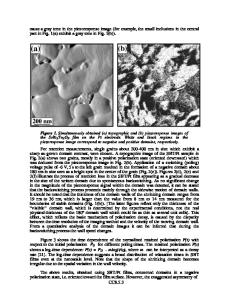Effect of La doping on the structural and electrical properties of SrBi 2 Ta 2 O 9
- PDF / 95,962 Bytes
- 6 Pages / 612 x 792 pts (letter) Page_size
- 102 Downloads / 351 Views
D3.24.1
Effect of La doping on the structural and electrical properties of SrBi2Ta2O9 Ortega Nora, S. Bhattacharyya, P. Bhattacharya, R.R. Das, and R.S. Katiyar Department of Physics, University of Puerto Rico, San Juan, Puerto Rico 00931-3343
ABSTRACT The effect of lanthanum substitution (0-20%) on phase formation, structural evolution and electrical properties of SrBi2 Ta2 O9 (SBT) ceramics were investigated. X-ray diffraction studies revealed that phase pure SBT bulk samples can be synthesized with lanthanum doping without any phase segregation. Raman spectroscopy was used to understand the lattice vibrational characteristics of La substituted SBT compound. The ferroelectric soft mode at 27 cm-1 was shifted towards the lower frequenc ies at room temperature with increase in La concentrations. The octahedral stretching mode (O-Ta-O) did not influenced by La substitution in SBT. The x-ray photoemission spectroscopy measurements showed the decrease of binding energy of Bi 4f core levels (5/2 and 7/2) upon La substitution in SBT. The dielectric constant was increased from 120 to 190 up to 10% La doping and decreased with further increase in La concentration. INTRODUCTION Bismuth- layered-structured- ferroelectric (BLSF) such as SrBi2 Ta2 O9 has attracted great interest as a potential candidate material for non- volatile random access memory (NVRAM) devices due to its polarization fatigue free nature (up to 1012 switching cycles with good retention) and low coercive field for polarization switching [1,2]. SBT (m=2) belong to the family of Aurivillius compound with a general formula of (Bi2 O2 )+(Am-1 BmO3m+1)2-, where A is 12-fold coordinated and B is 6- fold coordinated cations, in which the lattice structure composed of m- number of (Am-1 BmO3m+1 )2- unit cells sandwiched between (Bi2 O2 )2+ slabs along the pseudo-tetragonal c-axis [3]. The crystallization temperature (~750°C) of SBT is relatively higher in comparison to lead-based perovskites (~600 o C) [4]. Low remnant polarization (Pr ~10 µC/cm2 ) and high processing temperature are two major limiting factors for the practical use of the SBT based devices. Much research has been aimed to overcome these drawbacks by doping different concentrations of cations at Sr, Ta sites or by growing off- stoichiometric SBT with Sr deficient and Bi excess compositions [5-8]. Previously we have reported the enhancement of remanent polarization of SBT thin films by substituting Ca at Sr-sites [9]. Significant research has been done to understand the effect of cation substitution at Sr- and Ta-sites on the structural and electrical properties of SBT [4-9]. In our previous report we found, Nb-substituted SBT has high value of remanent polarization (~25.8µC/cm2 ) [10]. Recently, it is shown that Bi4 Ti3 O12 (BIT), which belongs to BLSF family with m=3, has high value of remanent polarization (~30 µC/cm2 ) with the substitution of lanthanides (i.e. La, Nd, etc.) at Bi-site [11,12]. It was reported that the processing temperature (~650 o C) of BIT is lower than SBT irrespective of
Data Loading...











